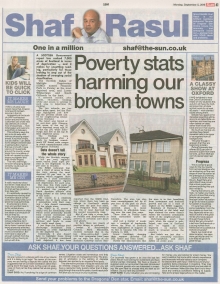A Scottish Government report has ranked 7,000 areas of Scotland from most deprived to least – and it makes for unsettling reading, particularly for those looking to escape sweeping social statements.
The Scottish Index of Multiple Deprivation (SIMD) named Ferguslie Park in Paisley as the most deprived area and Lower Whitecraigs and South Giffnock as the least. It assessed income, jobs, health, education, housing, crime and access to services in each area to determine the ranking.
The two suburbs are just eight miles apart, but the findings highlighted just how big the poverty divide can be for neighbouring estates across Scotland.
The report also hinted at an east/west split. Glasgow had seven of the top 10 most deprived areas and 56 of the top 100, while Edinburgh had five of the top 10 least deprived areas.
The findings were announced days after a study by business consultancy EY found wide variations in youth unemployment rates throughout Scotland. While the Scottish average is 14.3 per cent, regional areas varied from eight per cent in the Highlands to 19.4 per cent in Dundee.
The SIMD indicated that over a third of areas in Dundee were among the most deprived 20 per cent in the country which suggests there might be a close correlation between employment figures and deprivation for each area.
But does this truly paint an accurate picture of Scotland? For one, I noticed the outrage of North Ayrshire officials after being placed at the lower end of the scale. The county is a relatively affluent one in many areas, so I sympathise with their reaction – data doesn’t necessarily tell the whole story.
The SIMD is of course a useful tool for identifying areas which could potentially benefit from council investment and support from charities – helping local authorities allocate services and funds to areas that really need them.
I just hope the findings don’t discourage businesses from investing in areas highlighted on the deprived list.
Conversely, it also doesn’t help to highlight those living in poverty in areas considered least deprived.
It has been reported that the SIMD findings prove there has been no change in Scotland’s wealth map over the past four years, with Ferguslie Park receiving the title of most deprived for the second consecutive time.
But if you take a closer look at Paisley and Renfrewshire in general, it certainly isn’t doom and gloom. In fact, there’s plenty to celebrate.
Leader of Renfrewshire Council, Mark Macmillan recently revealed that in the last three-and-a-half years, 1,112 new companies have been set up with the help of the Business Gateway across Renfrewshire. The area has also seen unemployment fall by 43 per cent in the past six years.
The local council also unveiled plans to invest £34 million in affordable housing over the next five years with three sites in Paisley earmarked for the scheme.
And just a matter of weeks ago, a number of landmarks across the West of Scotland were lit up in support of its bid to become UK City of Culture in 2021. Iconic buildings showing their support included The SSE Hydro and Titan Crane.
Surely this demonstrates that the area is in fact benefiting from investment and business growth and not in a state of neglect as the SIMD suggests?
Residents of Ferguslie Park are horrified at the label and have claimed the status doesn’t reflect the fantastic community spirit of the neighbourhood.
Unfortunately, every four years when the report is published, one area of Scotland will be tagged as most deprived – no matter how much is invested across the country.
But labels are just that – they are something transitory and superficial, and don’t define an entire area.


